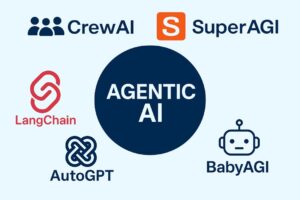Top 5 Agentic AI Frameworks -:

Here are top 5 Agentic AI frameworks that is trending these days -:
LangChain-
LangChain is a complete framework designed for creating applications that use large language models (LLMs). It focuses on developing smart agents that can think, plan, and interact with outside tools and memory. By allowing developers to connect LLM prompts, APIs, and data sources, it simplifies complex AI processes, making it ideal for activities like answering questions, summarizing information, and making decisions.
LangChain features memory modules that assist agents in maintaining context throughout interactions and integrates effortlessly with vector databases, APIs, and third-party tools. Its modular design allows for adaptable configurations, promoting both quick prototyping and scalable implementations. Additionally, LangChain facilitates tool usage and code execution, thereby enhancing the functionality of autonomous agents.
With a burgeoning ecosystem and an active community, LangChain is gaining traction in both enterprise and research environments, acting as a foundational element for intelligent chatbots, research assistants, and automation agents that necessitate persistent memory and multi-step reasoning.
AutoGPT-
AutoGPT is a new open-source framework that lets big language models like GPT-4 do complicated tasks on their own with very little help from people. It works by asking itself questions over and over: first, the model sets a goal, then it makes a plan, checks how things are going, and changes its approach until it finishes the task or hits a limit. AutoGPT can use tools like web browsers, file systems, and APIs, which means it can look things up online, summarize information, or even write and run code by itself. The framework uses a loop that acts like how we think—deciding and doing things—making it great for tasks that need to reach a goal. Even though it’s really powerful, AutoGPT can use a lot of resources and can be unpredictable, so it’s better for testing and trying things out rather than for regular use. It shows how LLMs can work in ways that act like agents, inspiring new types of AI that focus on solving problems and making decisions.
BabyAGI-
BabyAGI is a simple agent framework made with Python that mimics smart thinking by managing tasks in a step-by-step way.
It takes inspiration from how our brains work and follows a basic cycle: it creates tasks based on a goal, ranks them using a language model, and then does each task one after the other.
It uses embeddings to give context and memory, which helps the agent remember what it did before and the results it got.
People really like BabyAGI because it is easy to understand and use, making it a great tool for learning and trying out ideas about AI agents.
Even though it is simple, it can do some impressive things like planning tasks on its own, carrying them out, and adjusting to new information.
While it might not be as strong or flexible as more complex frameworks, its straightforward design helps developers quickly create agent behaviors without too much hassle.
BabyAGI is commonly used in schools, hackathons, or as a base for making custom agents that can handle specific tasks.
CrewAI –
CrewAI introduces a teamwork system with multiple agents, each designed for a specific job and purpose, which helps groups of agents work together on complex tasks.
Inspired by how real teams operate, CrewAI assigns roles to agents like researcher, planner, or executor, using a main control system to improve communication and task distribution.
This setup mirrors how human teams are organized, making it great for projects that required shared responsibilities, such as making reports, creating products, or conducting automated research.
Every agent has the ability to use tools and memory, share results along the way, and enhance their work through teamwork.
The framework offers developers modular APIs to establish agent behavior, capabilities, and communication protocols.
CrewAI shines in situations where coordinated actions surpass the performance of individual agents, delivering enhanced task efficiency, adaptability, and output quality.
Its focus on teamwork, role definition, and task orchestration establishes it as a robust framework for creating enterprise-level, collaborative AI systems.
SuperAGI –
SuperAGI is a strong platform that helps you create and use AI agents that can work on their own. It has cool features like using multiple tools together, managing memory, and tracking how well the agents are doing in real-time. Unlike simpler systems, SuperAGI focuses on being able to grow, keeping an eye on things, and being easy to change, which makes it great for big companies and businesses.
It can remember things for a long time using special storage, understand context with embeddings, and work with different tools like APIs, places to run code, and databases. SuperAGI also has a visual dashboard that lets you see how the agents are acting, how well they are performing, and how they make decisions right away.
It’s design enables developers to easily build, test, and enhance agents across various domains—from customer service bots to data analysis. SuperAGI includes safety features and methods for managing errors to ensure it delivers dependable results, which reduces the risks associated with autonomous AI systems. By combining flexibility with robustness, it empowers businesses to confidently and effectively leverage the capabilities of AI agents in practical scenarios.
For AI and ML courses – Dr Ai Academy
From queries to solutions in seconds – Our Chatbot is here